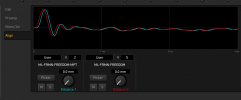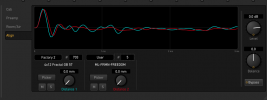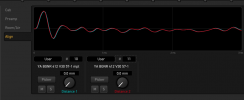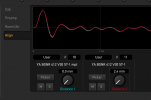DanielePanza
Inspired
Hi there,
I imported my @York Audio , @ML SOUND LAB and OwnHammer IR libraries into my FM3 with no Auto Trim nor Min Phase, as I figured that's the untouched, highest quality version of the files as provided by the vendors, and I never mix cabs from different developers, so no need for the extra processing.
However, I noticed that Natural Phase IRs don't work well with the Room/Air section of the cab block: somehow, dialling that in (I think Air causes the issue) seems to introduce phase issues which don't happen with MPT files.
I'm therefore going to re-import my entire library, and I was wondering if it's best to use the MPT files provided by the developers, or import the Natural ones and apply Min Phase on the FM3. Theoretically these should be the same, but I noticed that the Room/Air section interacts slightly differently with the MPT files than with the Natural files converted to MPT by the FM3. I think Natural ones converted by the FM3 work marginally better with the Air parameter, but I'm not 100% sure, as my ears are shut now, too much A/B-ing
I'm inclined to think that I should let the FM3 convert the IRs, as it would do it in such way that works best with its features, but advice/feedback from the IR developers and/or @FractalAudio would be MASSIVELY appreciated here!


I imported my @York Audio , @ML SOUND LAB and OwnHammer IR libraries into my FM3 with no Auto Trim nor Min Phase, as I figured that's the untouched, highest quality version of the files as provided by the vendors, and I never mix cabs from different developers, so no need for the extra processing.
However, I noticed that Natural Phase IRs don't work well with the Room/Air section of the cab block: somehow, dialling that in (I think Air causes the issue) seems to introduce phase issues which don't happen with MPT files.
I'm therefore going to re-import my entire library, and I was wondering if it's best to use the MPT files provided by the developers, or import the Natural ones and apply Min Phase on the FM3. Theoretically these should be the same, but I noticed that the Room/Air section interacts slightly differently with the MPT files than with the Natural files converted to MPT by the FM3. I think Natural ones converted by the FM3 work marginally better with the Air parameter, but I'm not 100% sure, as my ears are shut now, too much A/B-ing
I'm inclined to think that I should let the FM3 convert the IRs, as it would do it in such way that works best with its features, but advice/feedback from the IR developers and/or @FractalAudio would be MASSIVELY appreciated here!








